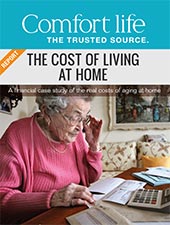What to know about this topic:
Sundown Syndrome (sometimes called Sundowner's Syndrome, or simply referred to as Sundowning) refers to a group of symptoms that often signify the progression of Alzheimer's Disease; it affects a significant percentage of Alzheimer's sufferers1 but is not limited to those with Alzheimer's and dementia. The syndrome is named for the fact that symptoms are especially noticeable at dusk or in the evening. It need not be the impetus to panic, but if you see indicators or this Syndrome, you should investigate these with the help of medical professionals.
If your loved one has been diagnosed with Alzheimer's, it is a strong indicator that they are in the middle stages of the disease. At this point, you should be researching memory care facilities near you, or at least home care services or adult day programs.
Symptoms related to Sundowning
The Syndrome's main symptoms are increased confusion and impromptu restlessness that may lead to wandering. (Note that wandering is especially dangerous at this time of day, with increased traffic combined with the evening's growing darkness). A full list of related behaviour is as follows:
- Increased confusion as the natural light of the day begins to fade.
- Agitation and mood swings toward anger and impatience. Individuals with Alzheimer's may become frustrated with their own confusion, thus exacerbating their irritability.
- Delusions or hallucinations
- Impulsiveness and suddenly erratic behaviour
- Restlessness while trying to sleep. While many older people need less sleep, the restlessness that leads to unnecessary pacing or wandering can be dangerous.
- Tremors that increase or become uncontrollable at this time of day
- Difficulty in understanding or communicating with others
- Difficulty with tasks that are otherwise managed with greater ease
- Paranoia and suspicion
One or two of the above behaviours may be typical of aging parents. However, if you notice more of these on a regular basis at or around sundown, it may indicate that this symptom group is in play.
Some research has shown that the area of the brain that signals the distinction between sleeping and waking breaks down in Alzheimer's patients and also deteriorates with age. Our internal mental clock breaks down over time, worsened in those with Alzheimer's Disease2.
Adjusting to Sundown Syndrome
In general, the Syndrome is associated with over-stimulation and stress. It can also be a side effect of some medications and of recovery from surgery. The Syndrome can be managed through several means, though. These include the following:
- Reduce over-activity during the day. If your elderly loved one has had an especially busy day, the possibility of confusion and other kinds of Sundowning increases. You can reduce the manifestations of the Syndrome by helping your aged loved one manage activity during the day.
- Establish a manageable daily routine, then keep it. This applies to all daily activities. You can ease the Syndrome by making lifestyle changes such as keeping meals and other daily activities on a schedule; this especially includes a regular bedtime routine.
- Reduce noise in the home (television and other media, etc.) Some sources recommend limiting TV viewing and monitoring what is watched, to avoid upsetting programs, news shows, etc. Make sure that radio or other music are played at a low volume.
- Manage lighting so it is not too bright (overstimulating) but also, not too dark. Add nightlights to darkened hallways and make sure all parts of the home are adequately lit.
- Limit caffeine and sugar intake to morning hours only.
- Maintain a familiar environment. Reduce strangeness and slowly introduce changes needed in the home of your elderly loved one.
- Medication can help alleviate agitation and other symptoms. Consult a physician.
- Natural and over-the-counter supplements. Vitamin E is known to reduce Sundowning in some cases. Herbs like ginkgo biloba have positive effects on brain maintenance and some Alzheimer's Disease effects, like Sundown Syndrome.
Be sure you consult with a medical professional to be sure that you understand the underlying cause of your loved one's Sundown Syndrome. If you make the above adjustments and your Sundowning parent has increased displays of Sundowning, you will need to take other action. An increasing number of memory care facilities have adapted environments and care options to help manage these symptoms.
Sundown Syndrome is another frustration for those who are aging or have been diagnosed with Alzheimer's Disease. Its predictability coupled with its inevitable negative effects make it aggravating but at the same time manageable to a degree. Some people with Alzheimer's Disease express symptoms of dementia evenly throughout the day; those with Sundown Syndrome may often show or feel symptoms in a more severe fashion that worsens as the day darkens.
Notes and further resources
1According to Wikipedia, Sundown Syndrome affects 20-40% of Alzheimer's sufferers, as per the Mayo Clinic. Alzheimer.ca puts the figure much higher, at 66%.
2webmd.com/alzheimers/guide/manage-sundowning
alz.org/care/alzheimers-dementia-sleep-issues-sundowning
Nina Khachiyants et al. "Sundown Syndrome in Persons with Dementia: An Update." Psychiatry Investigation. 2011 Dec; 8(4): 275–287. Published online 2011 Nov 4. doi: 10.4306/pi.2011.8.4.275. PMCID: PMC3246134/



